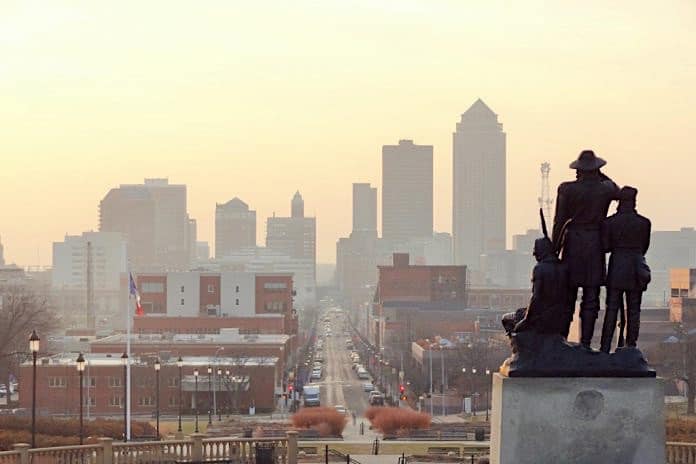The 16th National Congress of School Transportation moved to raise the profile of pupil transportation priorities among federal decision-makers, elevate diverse voices in the lead-up to the 2020 event and spelled out a more robust approach for interim updates to the National School Transportation Specifications and Procedures Manual.
“I’m really encouraged by the new interim process. It’s going to be a huge value in continuing the dialogue between the states,” said Theresa Anderson, a transportation management consultant based near Denver. “If you think things are not working, this is your forum. You can do something now instead of making a note to do it in four years and get a decision on it in five years.”
More than 300 delegates convened in Des Moines, Iowa, from last month for the first NCST ince 1985 that was held in a city other than Warrensburg, Missouri. The quinqennial event was moved to Des Moines when the University of Central Missouri and Missouri Safety Center announced last fall that they could no longer serve as event hosts or publishers of the NSTSP manual.
Steering committee member Ron Kinney, a representative of the Pupil Transportation Safety Institute, noted that the NCST began an interim amendment approval process when an urgent security issue arose in 2006.
Amendments submitted any time before the 2020 Congress will be reviewed by the steering committee to determine whether they should be adopted quickly or placed on the agenda. Matters requiring immediate attention will be sent to the appropriate writing committee if redrafting is needed, and then will be forwarded to state delegations for a vote.
“For the next two-and-a-half years, the (current) writing committees have to remain active,” Kinney said. “State committees have to remain active for the next five years. You can change faces, but you’re going to have to stay involved.”
Meanwhile, the group Women in Transportation submitted a resolution noting that the NCST steering committee was not comprised of women this year and urged the appointment of individuals for 2020 to “reflect the current diversity of the school transportation industry.”.
Speaking to fellow delegates on the NCST’s final day, steering committee member and Maryland Department of Education Director of the Pupil Transportation Leon Langley said, “I personally would like to have all those voices in the room.”
The resolution was approved by a 36-4 margin.
“Folks need to look at who they hire and encourage them to get more involved. And (employees) need to step up and raise their hands so they become the obvious choice for national leadership roles,” Langley said later.
Delegates also approved forwarding to the U.S. Department of Education the NCST’s new criteria about walking distances.
It reads, “Sole criterion used to establish transportation eligibility should not be only the distance between a student’s home address and the school of attendance, rather travel to and from school must take into account the ages of the students and potentially hazardous situations, such as roadways and walk pathway conditions, speed limits, railroad crossings, lighting conditions, etc. The criteria should also take into account students’ levels of maturity, grade levels, cognitive and physical abilities. similar criteria should be used in establishing maximum distances between a student’s home and the assigned bus stop per district guidelines.”
The resolution is intended as a clear message to federal officials that school transportation requires additional funding and that it is in the best interest of children and the public to increase the number of students transported by buses.
“Transportation always seems to be the first thing to get cut when money is tight and is always the last to get it back when it does come back,” said Charley Kennington, director of Innovative Transportation Solutions for Region 4 Education Service Center, in Houston. “Most transportation people don’t know that they can’t get the job done so we just do it. We have to do something to draw attention to this issue because we are continually doing more with less. It’s time we ran that flag up the pole to get people’s attention.”
Anderson said the action could be an important step in building closer working relationships with DOE personnel and a better federal understanding of the value of pupil transportation.
“It’s a recognition that our industry has changed in a way. We made the statement that if we’re not standing up for the kids and our industry, who will? We’re at the point where we’re ready to take that stand,” she said. “There are so many barriers to kids getting a good education that getting to school doesn’t need to be another one of them.”
She added: “The DOE is worried about curricula and test scores. We want to emphasize that getting kids to school safely is important, too, so we need to educate them about our industry. If a child is scared or tired or cold from a trip to school, they’re not going to be focused on curricula or test scores. Kids know they are safe on that school bus, and that puts them at ease.”
Related: EPA Awards Clean School Bus Grants in Several States
Related: EPA Accepting Applications for DERA School Bus Rebates Program
Related: EPA Extends Clean Diesel Tribal Grant Applications Timeline
Related: EPA Announces DERA Funding Recipients
Related: California Lower-Emission School Bus Program Issues Revisions
Related: EPA to Propose New Standard on NOx Emissions
Related: EPA Grant Brings 4 Blue Bird Electric School Buses to New York District
Related: EPA Announces Latest School Bus Rebate Awards

















